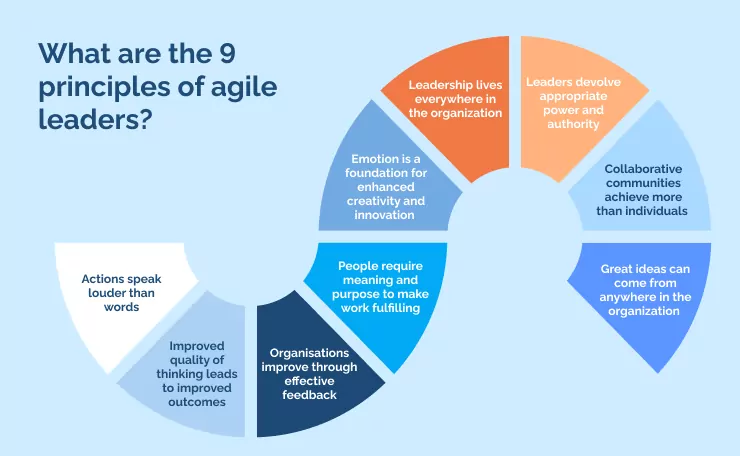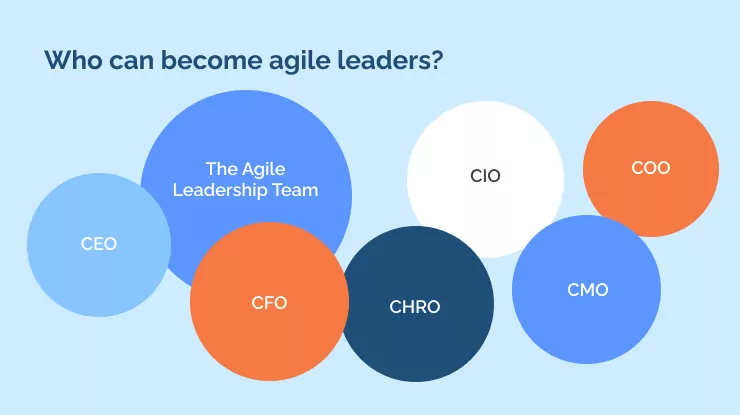
Agile leaders should inspire their teams like elite athletes inspire the country they represent.
While athletes impress with their physical prowess, agile leaders inspire and motivate with their unlimited resourcefulness, support, and understanding of the challenges of their staff within a constantly changing business environment.
By doing so, they fortify their organization by responding to political, financial, or technological challenges with digital resilience and sustainability, joining 71% of US companies who adopt the agile methodology, as reported by Zippia.
To help you understand precisely how to find your place as one of the most valued agile leaders in your organization, we will explore the following topics:
- What are agile leaders?
- What are the 9 principles of agile leadership?
- Who can become agile leaders?
- Strategies for agile leaders to build agile teams
What are agile leaders?

The agile leadership model does not revolve around specific methodologies like scrum, kanban, or work processes. It is more focused on adaptability and collaboration.
The idea of agile leaders comes from the principles of the agile manifesto created initially for agile software development, and the business world now applies it to many other business areas as a response to a lack of a marketplace status quo.
Being an agile leader relates to your worldview and how you support those in your workplace to embrace and implement an agile mindset to influence your organization positively by preparing for and embracing change.
To be an agile leader, you need to put aside your ego and be willing to collaborate with others effectively in your agile team. Doing so will enable you to showcase best collaboration practices as you empower teams to adapt quickly to a rapidly changing environment with a growth mindset.
What are the 9 principles of agile leaders?

The agile leadership style is a constantly changing approach as you move with the times, but one thing that remains stable is the foundation of agile leadership: the nine principles of agile leaders.
Principle 1 – Actions speak louder than words
Agile leadership involves not just pushing for change but also embodying it. Leaders who set an example and actively work on their growth are more likely to inspire others.
By 2023 it might sound a little cliche, but we can see this through actions; as Gandhi famously stated, “Be the change you want to see.”
Agile leaders strive to become more humble and empathetic by showing traits like compassion, kindness, and concern for their agile workforce. Influential leaders focus on personal development before trying to develop others.
Principle 2 – Improved quality of thinking leads to improved outcomes
Agile leaders prioritize quality thinking and meaningful action. They analyze problems from multiple perspectives, seeking input from those with firsthand knowledge.
Doing so ensures they are grounded in reality rather than relying solely on electronic data. Agile leaders allocate adequate time for thinking and prioritize tasks based on importance.
Principle 3 – Organisations improve through effective feedback
Agile Leaders take the initiative to ask for feedback from their colleagues, even though it may be unfavorable.
They respond to the feedback given and show that they take it seriously to complete the feedback loop. Additionally, they demonstrate how to provide considerate, truthful, and constructive feedback.
Principle 4 – People require meaning and purpose to make work fulfilling
The role of agile leaders is to create an inspiring vision of change that aligns with the organization’s values.
They prioritize building a shared understanding and purpose among colleagues. Agile leaders strive to understand their colleagues’ thoughts and feelings and use that knowledge to guide them toward a common goal.
Principle 5 – Emotion is a foundation for enhanced creativity and innovation
Agile leaders know the importance of emotions in the workplace and encourage their team members to work with their feelings to reach their full potential.
They promote respect by being transparent, honest, open, and accessible to themselves and by expecting the same from others. This action helps foster innovation and creativity in the team.
Principle 6 – Leadership lives everywhere in the organization
For effective organizational change, agile leadership must be present in all aspects. Doing so means unlocking leadership potential in all employees to speed up learning and adaptation.
Agile leaders should enable their staff to lead by creating opportunities for them. Nurturing tomorrow’s leaders through mentorship in servant leadership principles sets the foundation for a thriving agile culture.
Principle 7 – Leaders devolve appropriate power and authority
In the agile approach, leaders understand that people perform best when they feel enabled, engaged, and energized.
Thus, they aim to empower individuals, an essential skill for them to manage the ever-changing needs and tensions within the organization.
They also understand empowerment is not a polarized concept but a continuum of leadership behaviors that depend on the current context for change.
Principle 8 – Collaborative communities achieve more than individuals
Agile leaders establish communities that prioritize trust, respect, and meaningful relationships to promote efficiency and autonomy.
Their responsibility is to ensure the community has everything necessary to function while allowing them to operate autonomously within their set parameters.
The Agile Leader values forgiveness, positivity, generosity, and gratitude as crucial elements of a productive work setting.
The Agile Leader can foster growth and progress while achieving sustained organizational performance and output by prioritizing the team’s well-being and maintaining psychological safety.
Principle 9 – Great ideas can come from anywhere in the organization
Agile leaders recognize that the people most familiar with a problem are often the best source for solving it. They listen to and value input from others, regardless of their role or position.
They take time to understand their colleagues’ thoughts and ideas for improvement, even if they don’t use all of them. By doing this, they encourage a constant flow of creativity and provide feedback on which ideas were helpful and which were not.
Who can become agile leaders?

Many different roles can become agile leaders, and it’s essential to consider how these different roles can benefit their organization in unique ways based on their responsibilities.
The Agile Leadership Team
The agile leadership team usually comprises the company’s executive committee.
This team includes, at minimum, the CEO and the heads of finance (CFO), human resources (CHRO), technology (CTO), operations (COO), and marketing (CMO). These individuals are crucial to the various components of operations.
For most agile teams, members are allocated 100% to a single initiative. That’s not possible for agile leadership teams.
Executives must simultaneously play multiple roles that can benefit from agile leadership, including:
- Create and oversee the operating system for the agile enterprise.
- Diagnose which components need improvement with an agile approach.
- Ensure all business unit operations run reliably and efficiently.
- Serve as mentors, coaches, and decision-makers.
- Manage matters relating to corporate governance, including ensuring compliance and facilitating communication with shareholders.
- Tackle crises that may arise due to changes in the marketplace.
Handling these responsibilities is a tall order, vastly different from both a traditional executive committee’s work and that of textbook agile teams, which is why agile leadership will benefit the response to all these responsibilities.
CEO
Agile CEOs should spend less time on strategy and focus on operations.
In addition to other qualities, agile methodology calls for humility, so humble CEOs must know that predicting uncertainty is fruitless. Instead, they create swift feedback loops to keep track of operations.
They acknowledge that innovative and valuable ideas can originate from any team member, regardless of seniority.
CFO
The agile leadership team can work with the chief financial officer, who has expertise in applying financial tools, to develop and organize the corporate backlog of initiatives.
CFOs can instruct leaders of every agile team to prioritize their activities by creating a basic financial scenario. They can ask leaders to determine the amount of value lost if each initiative were to start six or twelve months later instead of starting immediately.
The responsibilities of the agile CFO are as follows:
- Revamping the planning, budgeting, and reviewing process.
- Resetting corporate objectives to reflect the new priorities.
- Creating recent financial reports for the strategic, agile initiative.
- Commission agile teams to develop planning and budgeting.
CHRO
The CHRO (chief human resources officer) has a large part to play in the agile leadership of their organization.
They should focus on reviewing the company’s talent engine to power an agile transformation, using the following strategies:
- Develop new career paths, appropriate reward systems for members of the significant agile initiative, and processes for backfilling their previous positions.
- Analyze the performance of the IT department’s past agile teams, who were using agile methodology much earlier than the rest of the company.
- Develop hiring, training, and coaching programs using agile methods in HR and helping cultivate common agile skills in technology and business areas.
- Clarify decision rights among agile teams and operating managers.
CIO
Since IT departments often have the most experience with agile, CIOs can take on the role of coach for the agile leadership team.
CIOs can highlight when team members follow agile principles and practices and slip into dangerous shortcuts or dead ends. They can also develop templates that outline the company’s requirements before launching for agile teams.
To be “ready to begin,” each team should do four things: identify a significant opportunity for customers, take ownership of specific results, assemble a team of specialized professionals, and commit to using agile principles.
COO
The chief operations officer can take on the role of chief integration officer to establish processes that allow agile innovation teams and operating units to collaborate and grow.
They can ensure that the teams designing new pricing strategies communicate with the pricing execution team and that groups studying customer-requested products work closely with their product managers.
CMO
The chief marketing officer’s responsibilities now include traditional branding and advertising tasks and assisting business units in recognizing and ranking strategic opportunities.
The CMO can compile scattered and sometimes contradictory reports from different business units into one central data source, which documents customer segments’ size, growth rates, evolving needs, and satisfaction levels with the company and its competitors.
They can also provide customer feedback by increasing its frequency and depth, collaborating with the CIO to implement advanced technologies that could learn from customer communities.
Strategies for agile leaders to build agile teams

Follow these strategies for agile leaders to build agile teams and distribute agile leadership principles throughout your organization.
Purpose: Find your shared vision
Leaders should develop the skill of creating a clear and compelling purpose for their organization that everyone shares.
This activity should not just be for the executive team in agile organizations. Instead, leaders should engage people across the enterprise to uncover and articulate the organization’s purpose.
Design: Utilize the practices and principles of agile organization design
Leaders need to develop the skill of designing the organization’s strategy and operating model using agile-organization principles and practices, the second organization-level skill.
However, most senior leaders of traditional companies have expertise in conventional organization design, a relatively concentrated, static system with one or a limited number of significant businesses, each having a long-established business model with a set of corporate functions, somewhat uneasily.
Culture: Nurture an agile organizational culture
Culture plays a crucial role in agile organizations due to the high level of openness and freedom experienced by individuals, which differs from traditional organizations.
Leaders must initiate a complex effort focused on their abilities and actions to influence the culture. This process involves following a set of steps:
- Model agile mindsets and behaviors to other leaders and team members.
- Inspire and engage frontline teams by sharing stories and encouraging their energy and ideas.
- Develop a culture of continuous learning throughout the organization, even among non-managers.
Through modeling, inspiration, and incorporating learning into your daily routine, you naturally strive to become a learning-centric organization, essential for developing an agile culture for digital resilience.
An agile mindset to fostering leaders
To introduce agile methodologies, organizations often begin with small pilots and focus on developing agile leadership skills in those areas.
However, for agile practices to be adopted successfully throughout the organization, top-level leaders must fully support and improve their capabilities.
Ultimately, a complete transformation to an agile mindset and set of skills will need to involve senior leadership at every enterprise level.
Five essential elements needed to carry out this task in an agile manner are:
- Agility coaches: Create a group of highly experienced enterprise agility coaches who can guide leaders through the journey with the backing of a team focused on transforming leadership.
- Developing skills: It is essential to involve the top team in developing their skills early, as other senior leaders will follow their example.
- Leadership program: Develop a comprehensive leadership program, from a concentrated effort over three or four days to a learning journey over several months, rolled out to all senior leaders for maximum impact.
- Agile initiatives: Invite leaders to put their learning into practice by applying it to ongoing agile-transformation initiatives and by initiating new experiments within the organization.
- Capabilities: Implement leadership capability building quickly, with a break every three months, to assess leadership experiences, experiments, and cultural changes and make adjustments.
Use a DAP to apply agile leadership to your organization
Agile leadership is an essential trait for a resilient leader. Agile leaders who recognize and respond to the ongoing changes in the marketplace will drive success and sustainability for their organization while inspiring team members and others to do the same.
Leveraging the DAP approach with its In-app guidance and personalized learning can help leaders make progressive, tailored decisions to achieve this goal.
So, if you want to develop the type of resilient leadership that drives success with market changes, consider implementing the DAP agile leadership approach and all the ways it could optimize your resilience to change today.
Tristan Ovington
Tristan Ovington is a professional senior writer and journalist, specializing in providing expert insights on various topics such as digital adoption, digital transformation, change management, and Cloud apps. He delivers his knowledge through accessible online content that is data-driven and presented in a friendly tone, making it easy for readers to understand and implement.


